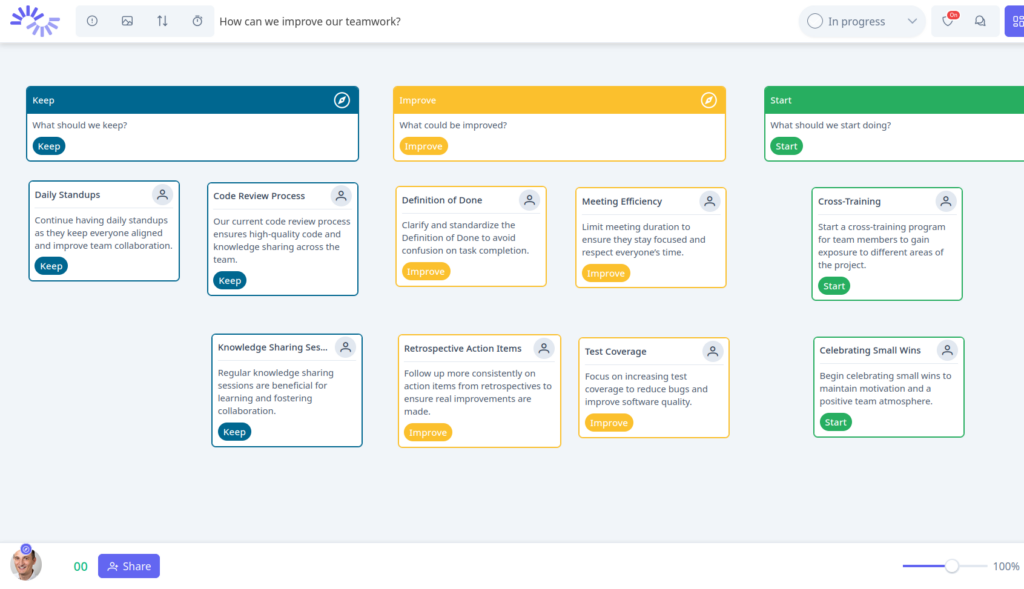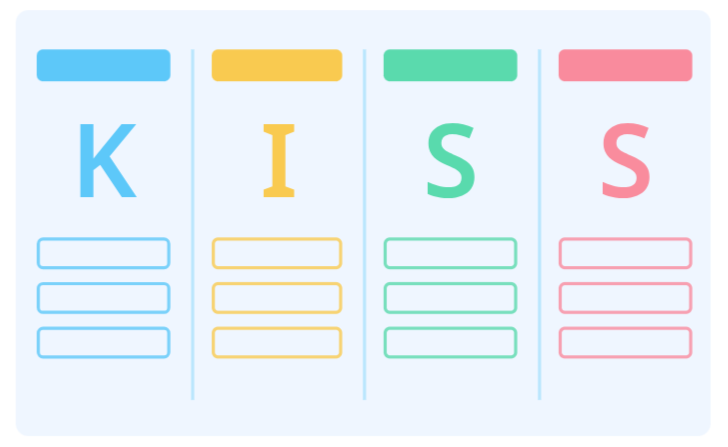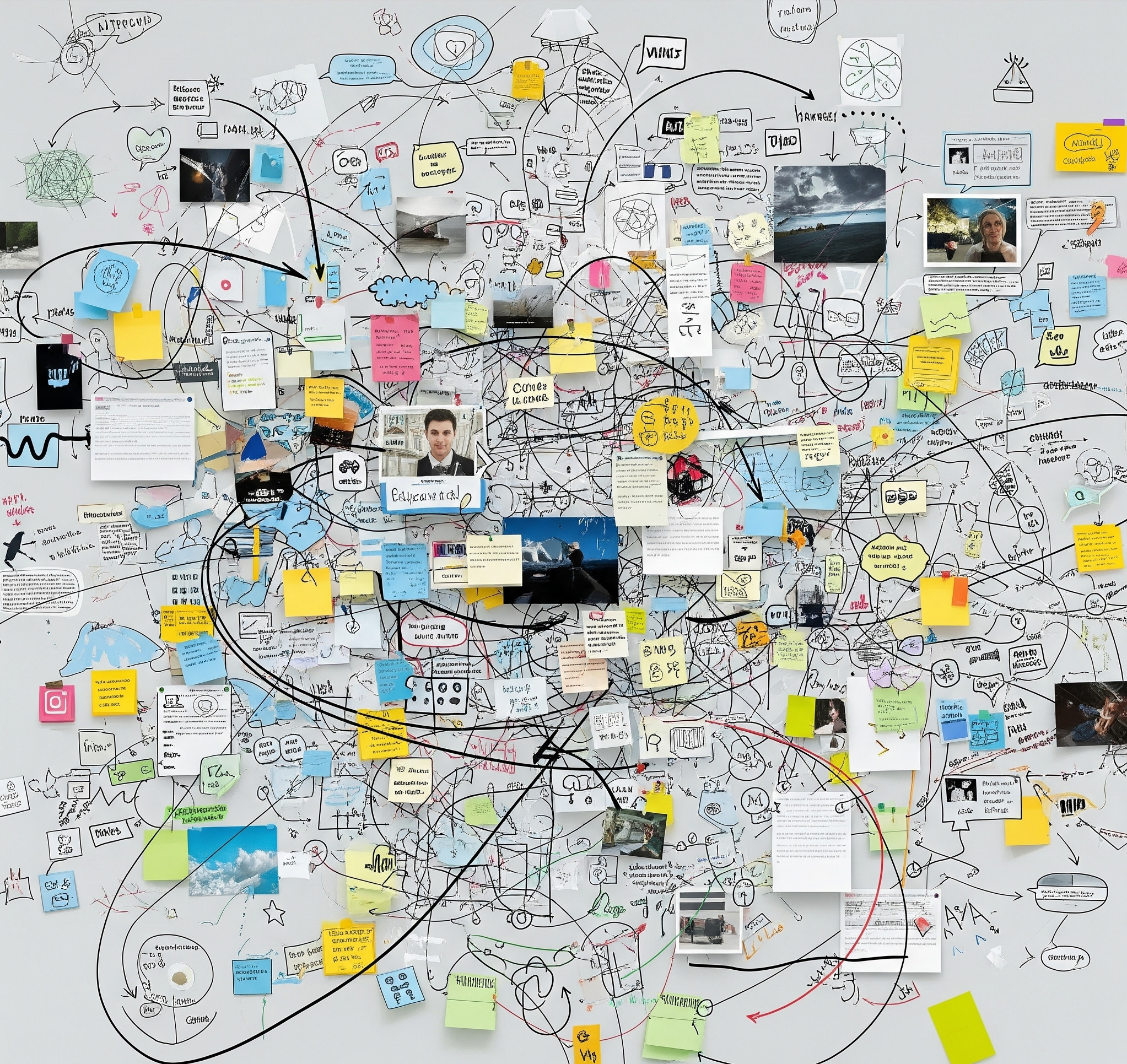KISS – short for ‘Keep, Improve, Start, Stop’ – is a straightforward retrospective technique that helps teams identify successes, uncover improvement areas and act on their insights.
What is the KISS retrospective?
KISS stands for “Keep, Improve, Start, Stop” – one of many powerful retrospective approaches designed to facilitate meaningful discussions and drive actionable results. It enables teams to reflect on their past efforts and collaboratively decide on the best course of action for continuous improvement.
Why choose KISS for your retros?
We understand that retrospectives play a critical role in the success of your projects. Here’s why you should consider using the KISS methodology:
- Structured Format: KISS provides a clear and structured framework for your retrospectives, ensuring that all important aspects are covered – from maintaining successful practices to identifying areas for growth.
- Collaborative decision-making: With KISS, your team engages in open discussions and shares insights on what to keep (Keep), what to improve (Improve), what new practices to adopt (Start), and what to discontinue (Stop).
- Focus on action: The KISS methodology emphasizes actionable results. At the end of the retrospective, your team will have a concrete plan to implement the identified improvements.
How to Run a KISS Retrospective: 4-Step Process
Running an effective KISS retrospective takes approximately 60-90 minutes depending on team size. Here’s the proven step-by-step process used by enterprise agile
teams:
Step 1: Set the Stage (5-10 minutes)
Begin by creating psychological safety and clarifying the retrospective’s purpose. Share the KISS framework with your team and explain that you’ll be collecting
input in four categories. Emphasize that all feedback is valuable and the goal is continuous improvement, not blame. Set ground rules for respectful dialogue and
remind the team that what’s discussed stays within the team.
Step 2: Gather Individual Input (15-20 minutes)
Ask each team member to anonymously contribute ideas in each KISS category:
- Keep: What practices, behaviors, or processes are working well and should continue?
- Improve: What existing practices need refinement or enhancement?
- Start: What new practices, tools, or behaviors should the team adopt?
- Stop: What current practices are hindering progress and should be discontinued?
Using tailored digital tools that enable truly anonymous contribution increases honest feedback by up to 60% compared to public discussion alone. The key is ensuring contributions remain anonymous during collection, preventing groupthink, dominance and hierarchical influence.

Step 3: Discuss and Prioritize (25-35 minutes)
Review all submitted items as a team, grouping similar ideas together. Facilitate discussion to ensure everyone understands each suggestion. Then use anonymous
voting or scoring to prioritize which items the team should address first. Focus on items with both high impact and feasibility – these “quick wins” build momentum for
ongoing improvement.
Step 4: Define Actions and Owners (15-20 minutes)
For the top 3-5 prioritized items, define specific actions with clear owners and deadlines. Avoid vague commitments like “communicate better” – instead, create
concrete actions such as “implement daily 10-minute standups starting Monday, facilitated by Sarah.” Document these action items and establish how you’ll track
progress before the next retrospective.
Facilitator Tip: The most effective KISS retrospectives spend 70% of time on action planning, not just discussion. Teams that leave with specific
commitments see 3x higher implementation rates than those with general agreements.
When to Use KISS Retrospectives (and When Not To)
KISS retrospectives excel in specific contexts but aren’t the best choice for every situation. Understanding when to use KISS versus alternative methods helps teams maximize the value of their reflection time.
Ideal Scenarios for KISS
The KISS retrospective method works exceptionally well in these situations:
- Time-constrained teams: KISS’s clear structure keeps discussions focused, making it ideal when you have limited retrospective time (60-90
minutes). - New or forming teams: The straightforward framework helps teams new to retrospectives participate effectively without extensive facilitation
experience. - Regular sprint retrospectives: KISS’s balanced approach to reviewing both successes and challenges makes it sustainable for recurring
retrospectives without feeling repetitive. - Cross-functional teams: The four categories are universally understood across roles, from developers to product managers to designers. KISS
retrospectives help teams identify collaboration barriers and establish shared working agreements, both critical elements of effective stakeholder alignment in enterprise initiatives. - Teams seeking actionable outcomes: KISS naturally drives toward concrete next steps rather than abstract discussions.
When to Consider Alternative Methods
While KISS is versatile, other methods in our Agile Retrospective Guide may be more effective for:
- Deep problem diagnosis: If your team is struggling with complex, systemic issues, methods like the “5 Whys” provide better root cause exploration.
- Relationship or trust issues: When team dynamics are strained, consider methods focused on building psychological safety first, such as “Appreciations” or “Team Health Check” retrospectives.
- Major project milestones: At project completion or major releases, more comprehensive methods like “Timeline” or “Sailboat” retrospectives help
capture the full journey. - Very large groups: For teams larger than 12 people, consider breaking into smaller groups or using methods specifically designed for scaling, such
as “Divide and Conquer” retrospectives. - Change fatigue: If your team has run KISS for many consecutive sprints, rotate to different formats to maintain engagement and surface new
insights.
Enterprise Insight: High-performing teams typically rotate between 3-4 different retrospective methods to keep sessions fresh while maintaining the
consistent practice of reflection and improvement.
KISS Retrospective Variations and Adaptations
While the standard KISS framework is powerful on its own, many teams adapt it to fit their specific needs. Here are proven variations used by enterprise agile
teams:
KISS vs. Start-Stop-Continue
Start-Stop-Continue is KISS’s closest relative, using three categories instead of four:
- Start: New practices to begin (same as KISS)
- Stop: Practices to discontinue (same as KISS)
- Continue: Combines KISS’s “Keep” and “Improve” into one category
When to choose Start-Stop-Continue: Use this simplified version for shorter retrospectives (30-45 minutes) or with teams very new to agile
practices. However, KISS’s separation of “Keep” and “Improve” provides more nuanced feedback – celebrating what works while still identifying enhancement
opportunities.
KISS + Impact/Effort Scoring
After collecting KISS items, teams plot suggestions on an Impact vs. Effort matrix to identify quick wins (high impact, low effort) and strategic initiatives (high
impact, high effort). This variation helps teams with limited capacity focus on changes that deliver maximum value.
KISS for Remote Teams
For distributed teams, enhance KISS with these adaptations:
- Pre-work phase: Give team members 24 hours before the meeting to add their KISS items asynchronously, allowing time for thoughtful
reflection. - Anonymous digital boards: Use tools that ensure anonymity during collection, which is especially important when camera fatigue or hierarchy
concerns may inhibit honest feedback. - Breakout discussions: For larger remote teams, divide into smaller breakout rooms to discuss specific categories, then reconvene to share top
insights.
KISS with Themes
Some teams add a fifth category or theme to focus discussions on specific areas:
- KISS + Technical Practices: Add a dedicated section for code quality, testing, or technical debt.
- KISS + Customer Focus: Include a category specifically for customer feedback and user experience improvements.
- KISS + Team Wellness: Add focus on team morale, work-life balance, and preventing burnout.
Experiment with these variations to find what resonates with your team’s context and challenges. The core principle remains: structured reflection leading to
concrete, actionable improvements.
Get More Retrospective Methods That Work
KISS is just one proven method. Get our complete toolkit with 6 structured techniques that help teams generate more actionable outcomes.

